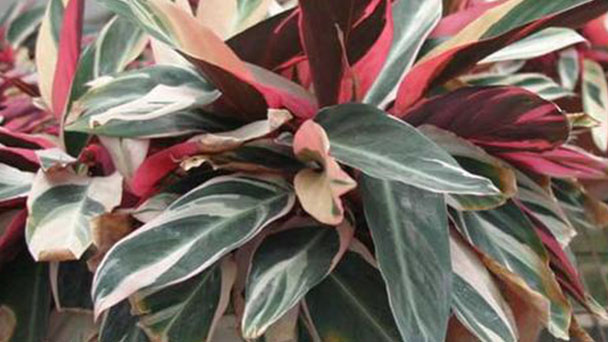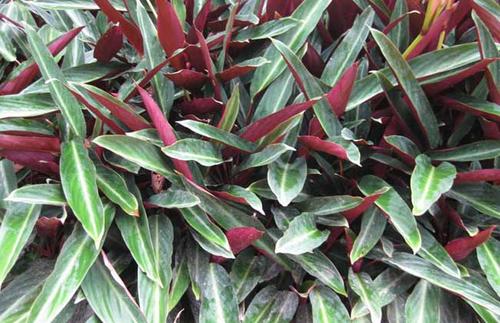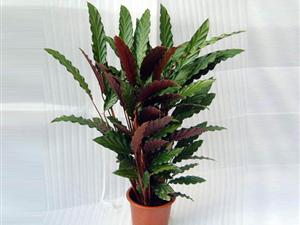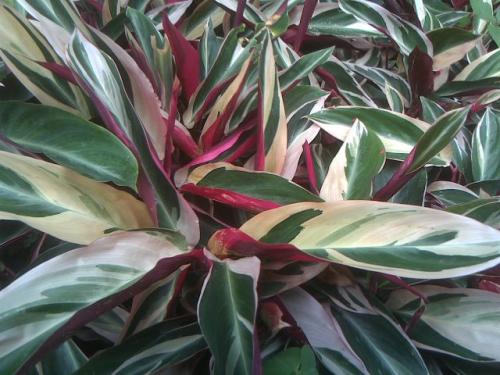Stromanthe Triostar (Stromanthe Sanguinea) Profile: Facts, Care & Growing Guide
Written by Maggie
Mar 15 2023

Stromanthe Triostar, scientific name Stromanthe sanguinea, belongs to the arrowroot family, arrowroot genus, perennial herbs. Stromanthe Triostar is up to 80 cm tall, erect. Leaf blade is long ovate or lanceolate. Its branches and leaves grow dense, plant shape plump, thick leathery, leaf surface dark green glossy, light veins, blood red back leaves, forming a sharp contrast. Spicate, bracts and calyx are bright red, petals white. The back is purple.
Stromanthe Triostar is commonly used to decorate the bedroom, living room, office and other places, appears quiet and solemn. stromanthe Triostar is an excellent indoor shade loving foliage plant. It is an excellent view leaves admire flower plants, used to decorate the place such as bedroom, sitting room, office, appear quiet, grave, can offer longer-term appreciation.
Stromanthe Triostar Picture

Stromanthe Triostar Info
| Botanical Name | Stromanthe sanguinea |
| Common Names | Stromanthe Triostar |
| Plant Type | Tropical perennial |
| Sun | Part sun |
| Hardiness Zones | 10 to 12 |
| Flower color | White |
| Native Area | Amazon jungle in South America |
| Mature size | 2 to 3 feet |
Morphological Features
Stromanthe Triostar (Stromanthe sanguinea) is a perennial herb with a plant height of 30 cm to 80 cm and a maximum of 1.5 m.
Leaves of stromanthe triostar are clustered at base, short stipitate, elliptic to broadly lanceolate, 30 -- 40 cm long and 8 -- 12 cm wide, dark green, glossy, purplish brown on the back.
Flowers of Stromanthe Triostar are bisexual, asymmetrical, often in pairs in bracts, forming terminal spikes, sepals 3, segregated; Corolla tube is short or long, lobes 3, outer 1 usually large and more or less hood shaped; Stamens 4-2, outer wheel 1-2 (sometimes absent) petalate, larger, inner wheel 2 in one cablelike, enclosing style, one hard leathery; The development stamen 1, petal shape, anther 1 locule, in one side; Ovary of Stromanthe Triostar is inferior, 3-1 loculed; Each locule has 1 ovule; Style is oblique, curved, broadened, stigma 3-lobed. Fruit is capsule or berry-like; Stromanthe Triostar has 1-3 seeds, hard, with endosperm and arp.
Stromanthe Triostar usually blooms in early spring, but it blooms quickly.
-profile.webp)
Ecological Habits
Stromanthe Triostar likes a warm, humid, shaded environment. The suitable temperature for growth is 20-30℃. It needs more water and is not drought tolerant. Stromanthe Triostar is heat resistant, slightly cold resistant, above 5℃ can be safe for winter.
Stromanthe Triostar is afraid of frost and prefers loose, fertile, moist and well-drained acid soil.
Stromanthe Triostar Care
Temperature
Stromanthe Triostar is native to tropical and subtropical areas, and likes high temperature, humid and semi-shade environments. The suitable growth temperature is 20-30℃, the best growth temperature is 18-21℃ in the daytime, 16-18℃ at night, and the safe overwintering temperature is 10℃. Therefore, in summer to prevent high temperature irradiation, put it in the shade;Winter should pay attention to the cold, the plant can be moved to a windless, warmer indoor winter.
Light Requirements
Avoid direct sunlight, Stromanthe Triostar is better to grow below indirect radiation light or scattering sex light. Especially in summer, direct sunlight is easy to cause leaf burns, so the production is cultivated in the artificial controlled light environment with a shading net of 75%-80% refluence. If burn is found on the leaves, it should be immediately removed to a place without direct light or shading facilities or under the shade of trees, and the burned leaves should be cut off to avoid the invasion of other pathogenic bacteria from the wound. At the same time, strengthen the management of water and fertilizer, promote its re-leaf, restore a new appearance.
Read More:
How Much Light Does Stromanthe Triostar Need?
Watering
The most suitable for the growth of air relative humidity from 75% to 85%, high air humidity is advantageous to the blade. Especially during the new leaf extraction, if too dry, the new leaf edge, leaf tip are easy to dry and curling, becoming deformed in the future.
Leaves cannot recover after wilting. Therefore, in the growing season, Stromanthe Triostar need to be frequently watered, and often spray to the foliage, 3-4 times a day in summer, and in time, the best watering method is spraying foliage in the morning, noon or afternoon pouring soil surface, the whole plant watering in the evening, but we should pay attention to the soil not too sticky, too wet, otherwise easy root rot and cause disease. After entering autumn and winter, the growth of Stromanthe Triostar slows down, the amount of watering should be gradually reduced. According to the weather change, watering 1 times a day or 2-3 days watering 1 times, especially when the temperature is low, the soil should be kept dry, so that it is free from cold damage.
Read More:
How To Save My Stromanthe Triostar Leaves Curling?
Soil Care
Cultivation soil requires fertile, loose and good drainage, avoiding soil compaction and water. Fertile humus soil and porous coarse media are often used as substrates. Generally with leaf rot soil and peat soil equal amounts of mixed configuration; Pond mud, peat and perlite can also be mixed in a ratio of 2:3:1. Or with loose foliar soil rich in organic matter plus 1/3 perlite, and then add a small amount of base fertilizer configuration.
Read More:
What Is The Best Soil For Stromanthe Triostar?
Fertilizer
According to the principle of "frequent and thin application", the compost of peanut bran and compound fertilizer or decompose compost should be applied once every 2 weeks during the growing season. The nutrient composition of fertilizer should be mainly nitrogen fertilizer, phosphorus and potash fertilizer. Because Stromanthe Triostar is a foliage plant, the appropriate increase of nitrogen fertilizer can make the leaf color more beautiful.
In addition, 0.1% solution can be prepared by urea with 46% nitrogen, and 0.2% solution can be prepared by adding potassium dihydrogen phosphate with more than 50% phosphorus and more than 30% potassium as root topdressing, which is better applied in the morning when the dew is not dry or at dusk. When spraying, a fine hole sprayer should be used to spray both sides of the blade, spray 1 times a week, continuous spray 3 times, stop 1 time, and then continuous spray. Special attention should be paid to the concentration of fertilization should not be too large, otherwise it is easy to cause leaf burns resulting in fertilizer damage, and even cause plant death in serious cases. Stop fertilizing during the winter dormant period and when it gets too hot in summer.
-profile-(2).webp)
Stromanthe Triostar Propagation
The vigorous plants of Stromanthe Triostar can be potted every 1-2 years. Planting should be carried out after the spring temperature warms up. The clumps are cut into a number of clumps along the direction of underground rhizome growth, and then planted in pots respectively, placed in a shady place for conservation, and the roots are to be grown and managed according to conventional methods. In addition, cutting propagation can also be carried out by drawing long knobbled stems and leaves.
Stromanthe Triostar is used to decorate bedrooms, living rooms, offices and other places, which looks quiet and solemn, and can be enjoyed for a long time. If you like it, you may wish to try planting and maintaining it to beautify your home. Stromanthe Triostar propagation methods and precautions to share with you here, more information please continue to pay attention to us.
How to Propagate Stromanthe Triostar by Division
Stromanthe Triostar general plant propagation, spring temperature about 20℃ reproduction is the most ideal, but as long as the temperature, humidity is appropriate, can also be carried out throughout the year. To propagate, a sharp knife is used to cut the root blocks with stems, leaves, or buds; A small amount of propagation can be cut root blocks with stems, leaves and leaf buds directly placed in the mud basin; When a large number of breeding, should be placed on the seedbed; When the temperature and humidity do not reach the requirements, the application of film cover; Be sure to make the temperature in the film to 20-28℃, humidity above 80%.
Propagating Stromanthe Triostar from Cutting
The cutting propagation of Stromanthe Triostar generally uses the top tender shoots, the length of the cuttings is 10-15 cm, depending on the size of the leaves, and one-third or half of the leaves are retained. The cuttings are treated with 500ppm Naacetic acid for 2-3 seconds, and can also be treated with indole acetic acid, indole butyric acid and ABT root powder.
The cuttings were inserted into the seedbed after treatment, and the spacing between the plants and rows was 5×10 cm. The top is covered with a thin film canopy, and the management method is the same as that of ramet propagation. Cutting propagation can be carried out at any time when the temperature is not lower than 20℃. Root 30-50 days for cuttings; However, the survival rate of cuttings was not as high as that of division propagation. It's usually around 50%.

Stromanthe Triostar Disease Control
The common diseases of Stromanthe Triostar (Stromanthe sanguinea) are leaf spot and leaf blight. At the beginning of the disease, 200 times of Bordeaux solution was sprayed 2 to 3 times every half a month. It can also be used 65% of the sun zinc wettable powder 600 times liquid spray prevention and control. The common insect pest mainly has scale insects, when the ventilation is poor and easy to occur. At the nymphal stage, spray with 50% borer pine emulsion 1000 times liquid.
Stromanthe Triostar is highly resistant and has few pests and diseases, but there are still some pests and diseases during the cultivation process under poor management. Common pests mainly scale insects, red spider, etc.; The common diseases are mainly white silk and leaf spot disease.
Scale insects
Scale insects are mainly mealybugs, which occur at the edge of Stromanthe Triostar leaves or on the back of leaves, and sometimes on the surface. They suck stromanthe triostar plant juice with the piercing suction mouthpiece, light leaf becomes yellow and aging, affects plant growth, serious withered leaves, fallen leaves, until the death of the whole plant; At the same time, the wound infected by scale insects are easily infected with the virus. Scale insects have a strong reproductive capacity and can reproduce for many generations in one year. The incubation period is in May. Adult scale insects have a waxy shell, general pesticides are difficult to enter, once they occur, it is difficult to control. When the Stromanthe Triostar indoor cultivation is not well ventilated, it is susceptible to the harm of scale insects.
Prevention and control method: according to the occurrence of scale insects, in the nymphal peak spray. Therefore, when most nymphs hatch soon, the body surface has not yet secreted wax, shell has not yet formed, medication is still easy to kill, every 7-10 days spray 1 time, continuous spray 2-3 times. It can be used to prevent and control by spraying 40% diethoate 1000 times liquid or 50% dichlorvos 1000 times liquid or 2.5% deltamethrin 3000 times liquid.
Read More:
Why Are My Stromanthe Triostar Turning Yellow Leaves
Starscream
Red spider harms Stromanthe Triostar more commonly, its small body, reddish-brown to orange, with sharp mouth needles to absorb the nutrients in the leaves, and cause the plant water and other metabolic balance imbalance, affecting the normal growth and development of Stromanthe Triostar. Red spider and so on in the high temperature and dry environment, insect reproduction quickly, serious harm.
Prevention and control method: keep the environment ventilated, make the environment humidity maintain above 40%, leaf back often spray water can control red spider reproduction.Because pesticides are difficult to kill the eggs, it is generally carried out in the adult and nymphal stage after the eggs hatch. It can be sprayed with 20% dichromatol emulsion 1000 times liquid or 40% diethoate emulsion 1000 times liquid.
Southern blight
The disease occurs more frequently on Stromanthe Triostar. Occurs, the stem or leaf base close to the soil becomes brown rot, grow white silk mycelium, radiate, can spread in the rhizosphere soil, and then cause the ground part of the wither and death; The initial stage is white, the later stage becomes yellow, and the final appearance is brown or brown like rapeseed, and then causes the ground part to wither and die. The disease was more serious in July and August, and the pathogen was small sclerotinia. The soil is too wet, infertile lack of fertilizer easy to come on.
Prevention and control methods: 70% pentachloronitrobenzene of 0.2% soil weight can be added to the soil to disinfect the soil; Before the formation of sclerotia, the diseased Stromanthe Triostar plant was removed, the surrounding diseased soil was excavated, and new soil was added. Attention should be paid to ventilation during cultivation to prevent over-dense planting.
Leaf spot
The disease mainly harms the Stromanthe Triostar leaf, but also the leaf sheath. At the beginning of the disease, the spots appear to be less than l mm in diameter, and then change to a reddish-brown spot about 2 mm in diameter without any halo around the spots. The disease can occur throughout the year, with two peaks in autumn and spring of the following year. At the peak of the disease, a large number of leaves of Stromanthe Triostar can be dried up, and the planting areas with poor management, poor ventilation, over-dense cultivation, stagnant water, poor soil, insufficient shade and poor plant growth potential can cause serious harm. The disease and residual body are the source of the initial infection of the disease.
Prevention and control methods: to increase the basic fertilizer, enhance disease resistance; Remove the diseased leaves of Stromanthe Triostar in time to reduce the source of bacteria; Before the onset of disease, start spraying 75% chlorothalonil WP 500-600 times liquid or spraying 75% chlorothalonil WP 1000 times liquid plus 70% methyl sulfur bacteria WP 1000 times liquid.
Read More:
How To Save My Stromanthe Triostar Brown Tips?

Stromanthe Triostar Distribution
Stromanthe Triostar is native to Central America and Brazil, and is cultivated in the southern provinces of China.
Uses of Stromanthe Triostar
- Ornamental Value
Stromanthe Triostar has underground rhizome or tuber, leaf solitary, larger. In addition to the open leaf sheath at the base of the leaf and petiole, there is a significantly enlarged joint, called "leaf pillow", which has water storage cells, regulating the direction of the leaf, that is, when the water is sufficient at night, the leaf is upright, and when the water is insufficient during the day, the leaf is expanded, which is a characteristic of araceae plants. In addition, some Stromanthe Triostar also 'sleep movement', that is, the leaf spread out during the day, the night folded, very peculiar.
- Indoor Decorate
Stromanthe Triostar because of strong negative resistance, beautiful leaf color, can be directly planted in hotels, shopping malls, large venues and other public places on the corner of the lot for permanent layout. However, in the process of cultivation and management, it is necessary to properly supplement the light and regularly spray water to the foliage to improve the air humidity.
-
Potted Plant Leaf Cutting
Stromanthe Triostar is one of the most famous indoor leaf viewing plants in the world because of its beautiful plant type, colorful leaf color and strong negative tolerance. It is used for indoor potted ornamental. Large breed can be used to decorate the hall of guesthouse, market, small breed can adorn the balcony of the bedroom, sitting room, bedroom, etc. In the process of cultivation and management, each placed for a period of time, Stromanthe Triostar should be placed in the balcony, window sill where the sun is strong, enhance the light, for long-term appreciation. Stromanthe Triostar is a high-grade leaf cutting material and can be directly used as flower arrangement or as lining material for flower arrangement.
-
Medicinal Value
Stromanthe Triostar rhizome contains starch, edible, with lung heat, diuresis and other functions.
-
Landscape Use of Stromanthe Triostar
Stromanthe Triostar has rich and colorful leaves and strong ornamental value. Most of them are shade plants with strong negative tolerance and strong adaptability. They can be planted in the shade of gardens and parks or by the roadside. Planting methods can be used in patches, clumps or with other plants.In northern areas, can be cultivated in the ornamental greenhouse for landscape ornamental.
Read More:
Is Stromanthe Triostar Toxic To Cats?
Calathea Triostar VS Stromanthe - Differences And Similarities
Latest Updated
- Stromanthe Triostar (Stromanthe Sanguinea) Profile: Facts, Care & Growing Guide
- Metasequoia Glyptostroboides (Dawn Redwood) Profile
- Can You Divide Peace Lily Plants - When Should You Split
- How to Grow Terminalia Mantaly Tree
- Why My Tea Olive Tree Dropping Leaves?
- How to Prune Peace Lily Plants - 2023 Essential Guide
- How to Growing Peace Lily In Water - Step by Step Guide
- How To Grow Peace Lilies Outdoors - Ways & What to Pay Attention
- Peace Lily Root Rot - Signs & How to Treat
- Why Is My Peace Lily Not Blooming - Causes & How to Get Them Bloom
Popular Articles
- Winter maintenance of Antirrhinum Majus
- How to Grow Terminalia Mantaly Tree
- How to Grow and Care for Crossostephium Chinense
- How to grow Antirrhinum Majus in spring
- Peristeria Elata (Dove Orchid) Profile: Info & Care Guide
- Underwatered Snake Plant (Sansevieria Trifasciata) - Signs And How To Fix
- Rosa Chinensis (China Rose): Plant Growing & Care Tips
- How to Care for Brazilian Jasmine Plant (Mandevilla Sanderi)
- How to Grow & Care for Graptopetalum Purple Delight in Summer
- How to Care for Baby Sun Rose (Aptenia Cordifolia)
-profile-(1).webp)